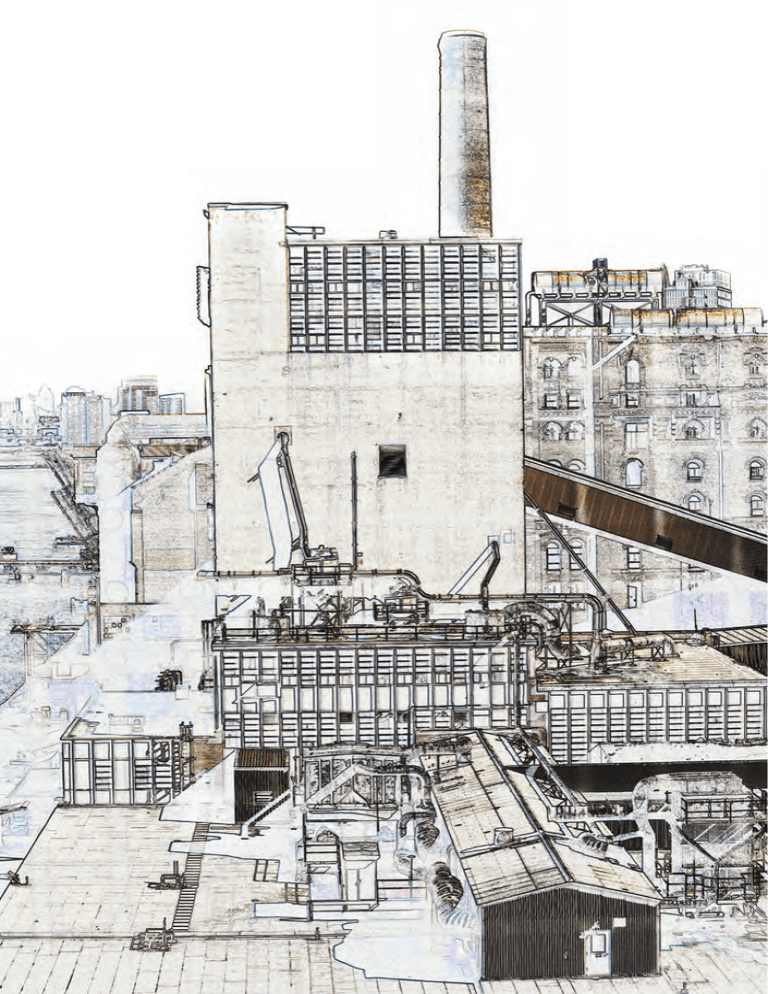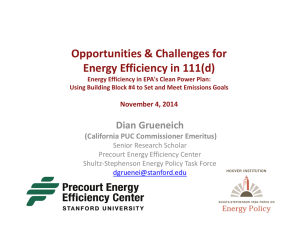24
advertisement

24 The Return of an Old and Battle-Tested Friend, The Clean Air Act Nathan Richardson, Arthur Fraas, and Dallas Burtraw The wheels of justice (and government) grind slowly, as it turns out. It was only in 2007 that the Supreme Court held in Massachusetts v. Environmental Protection Agency (EPA) that greenhouse gases were included in the act’s definition of “pollutants.” Before this decision, it was unclear whether carbon could be regulated under the act at all—the Bush-era EPA had argued that it could not be, and that new legislation would be necessary. The effects of this decision have taken some time to percolate through EPA’s regulatory apparatus and the policy community in general. While the Bush-era EPA did important preparatory work, it did not move to regulate carbon under any part of the act. Now, under the Obama administration, EPA has moved relatively quickly to bring the act to bear on greenhouse gas emissions. The agency issued an “endangerment finding” gettyimages Until recently, it has been widely assumed that U.S. action on climate change would come, if at all, through new legislation— most likely by pricing carbon within a broad cap-and-trade system. While almost all economists and policy experts still agree that legislation remains the best long-term option, it has become increasingly likely that in the near future the regulatory vehicle for carbon emissions will be an old friend: the Clean Air Act. The act is a battle-tested law: its predecessors were passed in 1963 and 1967 before substantial revision and expansion led to its modern form under Richard Nixon in 1970. Important further amendments followed in 1977 and again in 1990. So why is it being applied to greenhouse gas emissions only now? And why has its use moved to the forefront of the policy debate on climate change? ➜ Visit us for additional readings: www.rff.org/resourcesno176/richardson 25 are nominally defined as sources emitting greater than 100 tons per year, if the sources are associated with listed manufacturing source categories, or 250 tons per year otherwise. If this permitting process emerges as superficially required by the CAA, permits could be required for even very small emitters of greenhouse gases, likely including tens of thousands to millions of facilities that cumulatively account for a very small portion of emissions and have not been subject to Clean Air Act permitting processes in the past. To avoid this conundrum and improve the cost-effectiveness of permitting, EPA issued a rule to “tailor” the process—meaning that only large emitters would be affected, at least initially—but this approach is legally questionable. This tailoring rule has been challenged in court by some of the states that would be required to implement it and by firms that could be subject to the permitting process, though it is likely to enter into effect while that litigation is resolved. In addition, as a part of this process, the CAA requires that permits include controls based on a determination of the “best available for greenhouse gases, which legally established that greenhouse gas emissions threaten public health and welfare, a crucial first step. This finding formed the basis for the agency’s first carbon regulation under the act—new emissions standards for cars and trucks issued in March 2010. Although these moves focused on transportationsector emissions, they commit EPA to regulate stationary sources (power plants and industrial facilities) as well. At the same time, continuing congressional inertia means that there is no new comprehensive climate legislation. While new legislation would almost surely supersede and preempt at least some aspects of existing EPA authority, the current lack of action leaves regulation under the Clean Air Act (CAA) as the inevitable alternative. The result is that, at least over the short term, continued EPA moves to regulate carbon emissions under the act are likely. What that means in practice is only partly clear. The 2010 rules for cars and trucks show the agency’s plans for the transportation sector. Indeed, the transportation standards that will take effect over the 2012 The best and most likely CAA mechanism seems to be sectoral performance standards under the New Source Performance Standards (NSPS) program—which, confusingly, also applies to existing emissions sources. control technology.” It is unclear what such technology would be for greenhouse gas emissions. EPA has only just recently released guidelines for this determination. Even greater uncertainty exists about how EPA would regulate other existing stationary emissions sources—that is, the large fraction of existing sources that are not being modified. How the agency chooses to do so is the to 2016 period would be, if implemented today, among the most stringent such standards in the world. EPA has also clarified the timing for consideration of greenhouse gas emissions in the CAA permit process for all new stationary sources (and those undergoing major upgrades), but how this ultimately will be implemented is still uncertain. Under the act, major sources 26 Corbis At RFF, we have analyzed how EPA might use performance standards to regulate carbon emissions from one sector, coal power plants. Preliminary studies by EPA and the U.S. Department of Energy indicate relatively accessible emissions reduction opportunities from coal in the form of power-plant efficiency improvements and cofiring of biomass with coal. Traditional technology-based performance standards would allow EPA to require efficiency improvements. But market tools would allow the agency to reach these opportunities and those from biomass cofiring in a more cost-effective way. For example, EPA could implement an emissions efficiency-based performance standard, but allow plants to trade their progress toward that standard. Plants that could readily become more efficient or that could cofire biomass could sell credits to plants for which such actions would be more expensive. EPA might also generate a cap-and-trade system for coal plants largest unanswered question in this area, not least because these existing sources account for the majority of U.S. carbon emissions. EPA has a variety of tools available under the Clean Air Act, including setting a national air quality standard (the approach used for major traditional pollutants such as particulate matter and nitrogen oxides) or treating carbon as a hazardous pollutant (as is done for mercury, for example). Most of these approaches have significant legal and/or practical problems, however. The best and most likely CAA mechanism seems to be sectoral performance standards under the New Source Performance Standards (NSPS) program—which, confusingly, also applies to existing emissions sources. States would assume the primary implementation and enforcement role for existing sources under this program. Traditionally, these performance standards are technology-based, but the act appears to be sufficiently flexible for EPA to incorporate market-oriented mechanisms. 27 (and other categories of emissions sources) that would generate similar incentives. Our analysis indicates that CAA regulation of the coal sector could result in emissions reductions of between 5 and 10 percent, equivalent to up to about 3 percent of total U.S. emissions, without changing the level of electricity generation. This is not a large number, but it is not trivial either. It represents a significant portion of the reductions expected from coal-fired power plants under the “17 percent by 2020” goal articulated by President Obama in his pre-Copenhagen announcement and the House of Representatives in the Waxman-Markey bill. And these gains are only from one technology in one sector—CAA regulation of other technologies and sectors could achieve additional reductions. Others at RFF and elsewhere are studying the emissions reductions that might be possible from Clean Air Act regulation of other sectors, such as cement manufacture and petroleum refining. Achieving these reductions will require EPA to move beyond the permitting process it is currently implementing through the states to a more far-reaching and cost-effective focus on sectoral performance standards. through regulation would result in comparatively higher costs. Bold Action Needed Any enthusiasm about the Clean Air Act as a vehicle for carbon regulation should be tempered, however. First, achieving meaningful emissions benefits at reasonable A good case can be made that the Clean Air Act—if used wisely by EPA—can be an important vehicle for short-term greenhouse gas regulation. Although our evaluation does not yet estimate costs, there is reason to believe that such modest regulation would have modest costs. Because efficiency improvements and biomass cofiring would very likely be among the first moves made by coal plants under a carbon price (implemented, presumably, under new legislation), it is unlikely that requiring these moves cost, as our research suggests is possible, requires EPA to be bold. The agency must interpret sections of the act to enable use of trading mechanisms, must be ambitious in setting emissions targets, and must shift its focus to a new regulatory program. In short, to do all of this well, the agency will need to innovate. For an agency scarred by defeats in recent court battles, there may 28 iStockphoto take measures to protect trade-exposed industries, and can be bold without inviting litigation. It will be difficult for EPA to do any of these things with the tools it already has. With those reservations, however, a good case can be made that the Clean Air Act—if used wisely by EPA—can be an important vehicle for short-term greenhouse gas regulation. Given the inertia in Congress, that is good news. Not everyone agrees, of course—members of Congress from both parties have introduced measures to permanently or temporarily block EPA action on carbon under the act. But none of these proposals has succeeded, and even if one were to pass in Congress, the president would likely veto it. Until and unless this changes, or Congress passes climate legislation, the Clean Air Act can be effective in the short term. Moreover, it is the tool we have at hand and, because it is the law, a tool we are compelled to use. be little appetite for such ambition, though we can hope EPA will find new courage, not only to regulate but to do so intelligently. Second, EPA action under the act is a clear second-best option to new legislation from Congress, especially over the long term. While it is possible to identify some readily available opportunities for emissions reductions and push them via regulation (with market tools to keep costs down), it quickly becomes difficult to identify what steps should be taken next. A carbon price (either cap and trade or a carbon tax) created by legislation would allow the market to make these decisions. Comprehensive climate legislation could also establish a uniform carbon price across sectors, provide for international offsets, create greater opportunities for innovation, and include other cost-saving mechanisms that the Clean Air Act cannot provide. Congress can also make political tradeoffs between different parties that stand to lose or gain from carbon regulation, can 29






